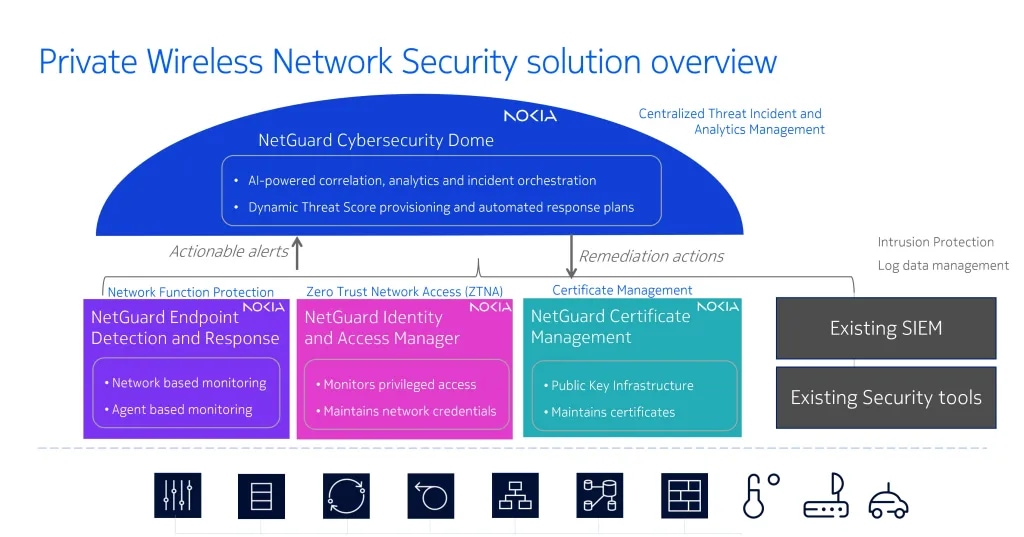From Meters to Megawatts: How Utilities Are Securing Private 5G

The growing demand for private 5G networks for mission-critical infrastructure underlines the need for comprehensive security solutions that deliver network visibility, granular access control, and advanced threat detection across both Information Technology (IT) and Operational Technology (OT) domains.
Unlike public 5G, private wireless networks give organizations full control over their infrastructure—ensuring secure, high-performance communications for applications where uptime is non-negotiable. Nowhere is this more critical than in utilities—energy, water, light, gas, and oil—where OT systems must operate with near-perfect reliability.
Lessons from the Early Adopters
Early movers like Southern California Edison, Memphis Light Gas Water, and Exelon have already navigated the complex first steps integrating comprehensive security, and ensuring regulatory compliance.
Today, they’re putting these networks to work for sophisticated use cases—real-time smart metering with 15-minute interval readings, AI-powered substation monitoring, and millisecond-level remote control of distribution networks spanning more than 10,000 square miles. These examples prove that with the right security foundation, private 5G is more than just a faster network—it’s a strategic asset.
Why Private 5G Needs Specialized Security
It’s easy to assume that because private 5G networks are not exposed to the same wide-open attack surface as public telecom networks, they’re inherently secure. That’s a dangerous assumption.
Public networks face well-known external threats—DDoS attacks, man-in-the-middle intrusions, signaling protocol vulnerabilities like SS7 and Diameter, and rogue base stations such as IMSI catchers. But private 5G has also its own risks: insider misuse, RAN misconfigurations like poorly managed certificates, and reduced visibility into attack attempts due to limited monitoring capabilities.
In utilities, where IT systems and OT systems such as SCADA, smart meters, and grid control must work in harmony, security cannot be bolted on after the fact. It must be built in from the design stage—using proven frameworks like the NIST Cybersecurity Framework and IEC 62351—to avoid costly retrofits and prevent security gaps.

Proactive Security for Private Wireless Networks
Mission-critical wireless networks—especially in utilities—can’t afford to play catch-up with cyber threats. Security must shift from reactive defense to proactive protection, where risks are predicted, detected, and neutralized in real time. Delays of even milliseconds can mean outages, data loss, or compromised control systems.
That’s why advanced tools—like AI-powered threat hunting, real-time intelligence, automated response, and cross-network alert correlation—are now essential, not optional.
Security Capabilities Overview
Centralized Cybersecurity Solution
NetGuard Cybersecurity Dome was built for this challenge. It brings together AI-driven analytics, tailored response playbooks, and native integration with Nokia’s broader NetGuard suite. It correlates telemetry across the entire network—radio to core—delivering visibility, control, and speed in responding to threats. It integrates seamlessly with tools like SIEM, asset management systems, and next-gen firewalls—creating a unified defense posture for high-stakes utility environments.

|
Network Function Protection |
Zero Trust Access Control |
Certificate Management |
|
Telecom-grade monitoring of VNFs, CNFs, and bare metal without disrupting service. NetGuard EDR uses AI to detect stealthy, multi-stage attacks in real time. |
Enforces role-based, granular access to network resources. NetGuard Identity Access Manager centralizes privileged access and blocks unauthorized activity. |
Manages device certificates for PKI tunnels between RAN and core. NetGuard Certificate and Lifecycle Manager handles secure issuance, renewal, and revocation. |
The Real Price of Doing Nothing
Whenever I speak with utility leaders exploring private 5G, one question inevitably comes up: Is the added cost and complexity of securing the network worth it? My answer is always the same—the cost of inaction is far higher.
Cyberattacks on critical infrastructure aren’t just IT problems—they can lead to operational outages, multi-million-dollar losses, regulatory penalties, and, in worst cases, threats to public safety. In an industry where uptime is measured in “nines,” even seconds of disruption can have massive consequences.
Fortunately, modern security tools have caught up with the challenge. Cloud-native, scalable platforms now deliver enterprise-grade protection without the heavy footprint of legacy systems, allowing utilities to strengthen defences without slowing innovation.
Building a Private Wireless Network That Lasts
Private 5G is enabling the kind of innovation that was previously out of reach—real-time grid control, AI-driven predictive maintenance, and operational automation at unprecedented scale. But the convergence of IT and OT also expands the attack surface, making an integrated security strategy essential from day one.
A robust framework must cover threat incident management, network visibility, identity control, and proactive threat prevention—not as afterthoughts, but as core design principles. In this environment, “we’ll secure it later” isn’t a plan. It’s a liability.
That’s where Nokia’s experience stands out. With over 920 private wireless deployments worldwide, Nokia has built security directly into the network’s DNA. The NetGuard portfolio—spanning network function protection, zero-trust access, and certificate lifecycle management—integrates seamlessly into complex utility and industrial environments. This isn’t just about protection; it’s about enabling innovation without hesitation.
Take the Next Step: Strengthen Security in Private Wireless Networks
To dive deeper into how private wireless networks can enhance the security and resilience of utility infrastructure, we invite you to:
📄 Download the complimentary Hardenstance whitepaper:
Securing a Utility’s Private Wireless Network – a must-read from industry analysts exploring the evolving threat landscape and strategies for securing critical operations.
🗓️ Register for our upcoming online panel discussion:
Join industry experts and security leaders for a live session on “Security for Private Wireless Networks”, where they’ll discuss real-world use cases, threats, and best practices tailored for the utilities sector.




